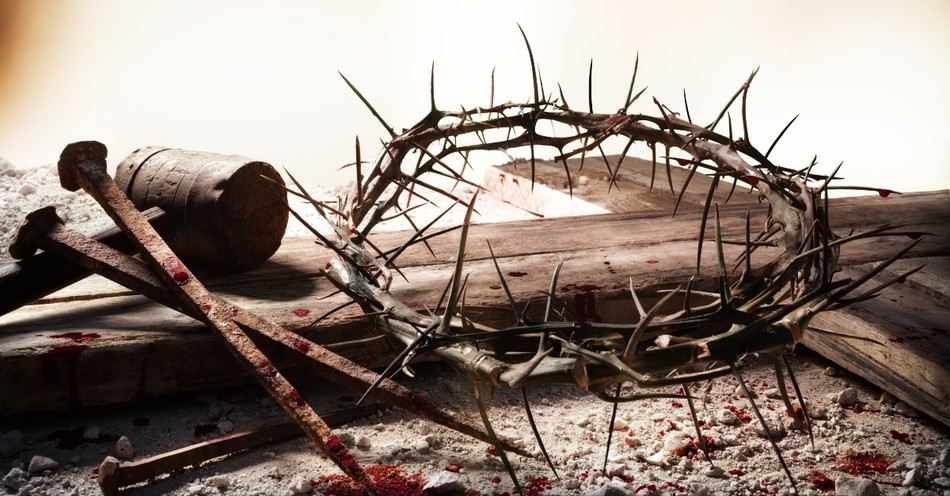We know that God sent His son Jesus to earth to provide a pathway to salvation for Gentiles. Gentiles are those who are not of Jewish background. God had already given Hebrews access because of the Abrahamic covenant. Jesus became the Lamb so that humanity would have access to God’s forgiveness. We know Jesus was convicted of blasphemy because He declared that He was the Son of God. His accusers flogged Him and made another man carry His cross. They crucified Jesus on the cross between two thieves. What else do we know about the crucifixion of Jesus?
Get your FREE Holy Week Guide here. Have encouragement delivered straight to your inbox!
What was the Crucifixion of Jesus?
The crucifixion of Jesus is the slaying of the lamb for humanity. Jesus’s death made atonement with God for man. Before Christ came to earth, man-made sacrifices of calves or lambs to God for the atonement of sin. Since the fall of man, God had devised a plan for those who were not initially a part of the Abrahamic covenant to be grafted in for forgiveness of sin. This grafting is made possible because of the blood that was shed at Calvary. Jesus’ death was necessary and the only way the rest of us would not be lost.
The Crucifixion in the Bible
I find most references to the crucifixion in Matthew 26 and Matthew 27. We also see accounts of the crucifixion in Luke 23, John 18 and John 19. Some recollections are different from book to book of the Bible. All accounts reveal that Jesus was mocked, ridiculed, and called the King of the Jews. Others tempted Him to use His godly power to come down from the cross if He be the Son of God.
The Crucifixion of Jesus
As they were going out, they met a man from Cyrene, named Simon, and they forced him to carry the cross. They came to a place called Golgotha (which means “the place of the skull”). There they offered Jesus wine to drink, mixed with gall; but after tasting it, he refused to drink it. When they had crucified him, they divided up his clothes by casting lots. And sitting down, they kept watch over him there. Above his head they placed the written charge against him: this is jesus, the king of the jews.
Two rebels were crucified with him, one on his right and one on his left. Those who passed by hurled insults at him, shaking their heads and saying, “You who are going to destroy the temple and build it in three days, save yourself! Come down from the cross, if you are the Son of God!” In the same way the chief priests, the teachers of the law and the elders mocked him. “He saved others,” they said, “but he can’t save himself! He’s the king of Israel! Let him come down now from the cross, and we will believe in him. He trusts in God. Let God rescue him now if he wants him, for he said, ‘I am the Son of God.’” In the same way the rebels who were crucified with him also heaped insults on him. (Matthew 27:32-44)
The Death of Jesus
From noon until three in the afternoon darkness came over all the land. About three in the afternoon Jesus cried out in a loud voice, “Eli, Eli, lema sabachthani?” (which means “My God, my God, why have you forsaken me?”).
When some of those standing there heard this, they said, “He’s calling Elijah.”
Immediately one of them ran and got a sponge. He filled it with wine vinegar, put it on a staff, and offered it to Jesus to drink. 49 The rest said, “Now leave him alone. Let’s see if Elijah comes to save him.”
And when Jesus had cried out again in a loud voice, he gave up his spirit.
At that moment the curtain of the temple was torn in two from top to bottom. The earth shook, the rocks split and the tombs broke open. The bodies of many holy people who had died were raised to life. They came out of the tombs after Jesus’ resurrection and went into the holy city and appeared to many people.
When the centurion and those with him who were guarding Jesus saw the earthquake and all that had happened, they were terrified, and exclaimed, “Surely he was the Son of God!”
Many women were there, watching from a distance. They had followed Jesus from Galilee to care for his needs. Among them were Mary Magdalene, Mary the mother of James and Joseph, and the mother of Zebedee’s sons. (Matthew 27:45-56)
What Happened During the Crucifixion of Jesus?
If you have read the Bible and seen the movie Passion of the Christ, you know a few things about the crucifixion. Jesus was betrayed by Judas, as was prophesied. Complete details of events leading up to the crucifixion are listed in Matthew 26 and Matthew 27. Crucifixion details are also listed in Luke 23, John 18, and John 19.
It is important to note that Jesus was arrested by the religious leaders of the day. The chief priests and elders asked Jesus if He did not say that He is able to destroy the temple of God and to build it in three days. They asked Him if He was the Son of God. Jesus’ answer so angered them. “Thou has said: nevertheless, I say unto you, Hereafter shall ye see the Son of man sitting on the right hand of power and coming in the clouds of heaven.” One high priest tore his clothes and said this was blasphemy. The chief priests and officers wanted Jesus to die because He said that He was the son of God. They found this very offensive and did not want to believe the truth.
Before Pilate turned Jesus over to be crucified, the crowd mocked him. Pilate had scourged Jesus. The soldiers put a crown of thorns upon His head and a purple robe on Him hailing Him King of the Jews. Pilate said that he found no fault in Jesus. There was a custom to release a prisoner during the Passover. The crowd did not want Jesus released. They chose instead Barabbas a robber. From the Bible details, it appears that Pilate made several attempts to have his hands clean of the matter. He asked them in many ways what they would have him to do with Jesus.
The Romans led Jesus to Golgotha while another man dragged the cross that he would die on. They gave Jesus vinegar to drink. After tasting it, Jesus would not drink it. Soldiers cast lots for Jesus’ clothes. Explicit details of the crucifixion are not listed in scripture. We do know about the crucifixion process. During this process, Jesus was nailed to the cross with His arms stretched wide. His hands were nailed to the cross and his feet were nailed. The nails were so strong that Jesus hung there until He died and gave up the ghost.
After Jesus died, “the veil of the temple was rent in two from the top to the bottom; and the earth did quake. Graves were opened, bodies of saints arose and appeared to many. Those watching the events then believed that He was the Son of God.”
When Did Jesus Die?
The exact date of Jesus' crucifixion is a subject of historical and scholarly debate, but it is generally believed to have occurred in the first century AD. Most scholars and historians place the crucifixion of Jesus between 30 and 33 AD during the rule of the Roman governor Pontius Pilate. The specific date varies depending on the source, but it is often associated with the Jewish festival of Passover.
When we examine the evidence, Friday fits best with the Gospel accounts and the historical context for the day Jesus died. For example, the New Testament says that Jesus rose from the dead on the third day—not necessarily after three full, literal days (e.g., Matthew 16:21; Acts 10:40). Jesus had to be rushed into the tomb on the day of preparation. While a Friday crucifixion would necessitate a "silent day" (probably Wednesday), this day allows time for the Sanhedrin to plan for Jesus's arrest and the subsequent trials. So, the day is only "silent" because we have nothing specifically recorded.
According to the biblical accounts of Jesus' crucifixion, he was nailed to the cross sometime between the third and the sixth hour, which corresponds to the hours between 9:00 AM and 12:00 PM. The Gospels describe how Jesus endured the agony of the cross during those morning hours.
His death on the cross occurred shortly after the ninth hour, which translates to the time between 3:00 PM and 4:00 PM in the afternoon. It was during this period that Jesus breathed his last breath, marking the culmination of his suffering and the moment of his death.
Given that Jesus was killed during the daytime, we may wonder why Matthew says there was darkness covering the sky when Jesus died. G. Campbell Morgan discusses several theories:
"Much has been written about the three hours of darkness (Matthew 27:45), much of which is not warranted by any careful spiritual attention to the story itself. Many years ago, it was argued that the darkness was that of the sun's eclipse. But that is entirely impossible, for Passover was always held at full moon, when there could be no eclipse of the sun.
The darkness has been described as nature's sympathy with the suffering of the Lord, but that is a pagan conception of nature, a conception of nature as having some consciousness apart from God and out of harmony with His work.
It has been said that the darkness was brought about by an act of God and was expressive of His sympathy with His Son. I immediately admit that that is an appealing idea and has some element of truth in it, in that we may discover the overruling of His government; but to declare that that darkness was caused by God because of His sympathy with His Son is to deny the cry of Jesus which immediately followed the darkness and referred to it. The darkness was to Him a period when He experienced whatever He may have meant by the words, "Why have you forsaken Me?"
(Adapted from The Darkness of Golgotha, by G. Campbell Morgan.)
Why Was Jesus Crucified?
Jesus was sent to earth by God so that He would be the go-between for humanity. His purpose was to come to earth, preach the Gospel for 33 years, and be crucified. This was a hard task even for Jesus. He spent much time in prayer seeking God’s will concerning this event. “O my Father, if this cup may not pass away from me, except I drink it, thy will be done.” Events leading up to the crucifixion have Judas Iscariot betraying Jesus. Jesus had already prophesied that one of them would betray Him.
While Jesus was being arrested and betrayed by one of his disciples, He stressed the fact that He was laying down His life. He said, “Thinkest thou that I cannot now pray to my Father, and he shall presently give me more than twelve legions of angels. But how then shall the scriptures be fulfilled, that thus it must be?”
What Led Up to the Crucifixion of Jesus?
Even before His betrayal, Jesus is being prepared for burial. In Mathew 26, a woman having an alabaster box pours “very precious ointment” on His head. Those assembled with Him questioned why she did it and saw it as a waste. Jesus asked them not to trouble her because she did it for His burial. Judas Iscariot went unto one of the chief priests and asked what they would give him to turn over Jesus. They told him 30 pieces of silver. From that moment, he sought to betray Jesus.
During the last supper, Jesus tells his disciples, "one of you shall betray me." The disciples asked, “Lord is it I?” When Judas asks, "Lord is it I?" Jesus replied, “Thou hast said.” Jesus also tells them it was best if the betrayer had never been born. We find later in Matthew 27 that Judas hangs himself after betraying Jesus.
The Bible says that all His disciples forsook Him and fled. Many had declared that they would not leave. Peter denied Jesus three times when asked about Him and his association with Jesus.
Three Things Christians Should Know About the Crucifixion
First, Jesus died for us. He died so that we might live.
Secondly, it would be virtually impossible for us to live up to God’s standards. We know that the Word says that God’s commandments are not grievous.
Thirdly, a good percentage of Christians are not Jewish. We do know that God has a special relationship with the children of Israel because of His covenant with Abraham and Jacob. Jesus came to provide access to those who are not of the Abrahamic covenant.
We must spend our time witnessing. We do not know when Jesus will be sent back to collect the church. The Bible says that He will come as a thief in the night. Jesus does not even know when He is coming back. Only God knows that. It is up to us to be ready and to tell others about the plan of salvation.
Further Reading
The Crucifixion and Death of Jesus - Bible Story
Jesus on the Cross - 10 Powerful Facts About the Crucifixion
5 Beautiful Reminders about the Crucifixion of Jesus
Photo credit: iStock/Getty Images Plus/RomoloTavani

Learn more about the meaning and significance behind the Easter holiday and Holy Week celebrations:
What is Lent? and When Does Lent Start?
What is Ash Wednesday? and When is Ash Wednesday?
What is Palm Sunday?
What is Maundy Thursday?
What is Good Friday? and When is Good Friday?
What is Holy Saturday?
What is Easter? and When is Easter Sunday?
Easter Bible Verses
The Resurrection of Jesus
Easter Prayers









